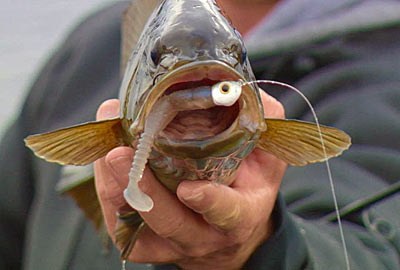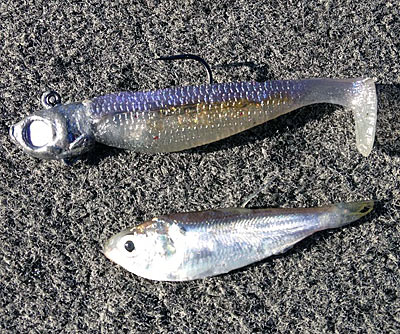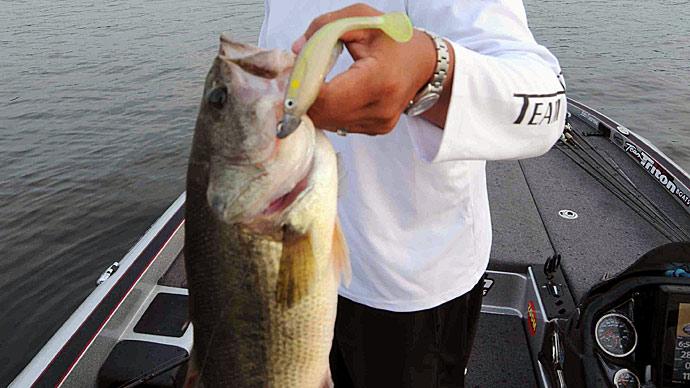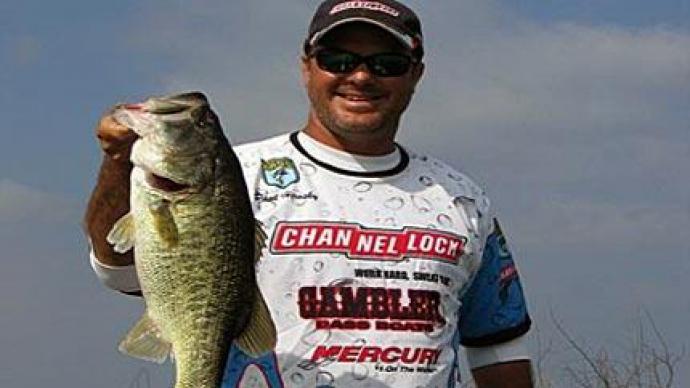
With the air temperature near single digits at takeoff and no hope of it warming much past freezing later that February day, Paul Mueller and his fellow competitors bundled up and set off for Day 1 of the 2015 Bassmaster Classic on Lake Hartwell. Some found their first spots iced over, contrasting to the much warmer practice days when he caught plenty of largemouth by cranking shallow water. While the cold snap broke that pattern, he had the tools to fix his situation.
Mueller lives in Connecticut and chases bass in his fair share of cold water. It has allowed him to fashion and practice tactics for the situation he faced at Hartwell. So, he changed spots, heading to deeper water where spotted bass, hunkered in ditches, were more willing to bite than the largemouth. He also changed his lure, casting a small swimbait to catch 38 pounds and 6 ounces over three days, earning him 12th place.
All bass anglers know that swimbaits are potent bass catchers during spring and summer when warm water makes bass aggressive. But many put them away in late fall and winter. They shouldn’t. The productivity of these soft-plastic lures, especially when rigged on jig heads, doesn’t slow down when water temperatures drop. Like the bass, they need to adjust to the conditions.
Why Fish Them
Mueller was familiar with the swimbaits he fished during the 2015 Classic before arriving at the 56,000-acre reservoir along the Georgia-South Carolina line. He has used them to catch plenty of late fall and winter bass from New England lakes and while on the road, including at two Tennessee smallmouth factories — Dale Hollow Reservoir and Cherokee Lake. The latter hosted a Bassmaster Elite Series tournament in February 2017, when he used a small swimbait to catch a few key smallmouth each morning before the sun came up and they suspended. He finished the four-day tournament with 20 smallmouth weighing 65 pounds, which earned him fifth place.
Mueller said that the best cold waters for fishing swimbaits, like those mentioned above, have large populations of baitfish. They often are small, about 3 inches or less in length. “That’s when it works,” he said. “It’s just [matching your swimbait’s size to] what things fish are feeding on.”
Cold-water fishing demands slow presentations. As the water temperature falls, cold-blooded bass become increasingly sedentary and bottom-oriented. Mueller said their strike zone — how far and fast they’ll move to bite a lure — shrinks, narrowing your selection of productive lures and techniques. In other words, you can leave your lipless crankbaits at home because these bass aren’t in a chasing mood.
Mueller said that lack of inspiration is why more and bigger bass have been caught from cold water with smaller, lighter, and slower lures such as hair jigs. But they do have one downside, and that’s their slowness. They take longer to sink to deeper depths, and he said a slower retrieve, usually with plenty of pauses, is needed to keep them there.
Those constraints don’t entirely apply to swimbaits. “That’s the beautiful thing when you fish a swimbait, you can cover water,” Mueller said. “You can’t do that with a drop shot or a hair jig.” That mobility is a function of the steady, slow-rolling retrieve he uses to keep his swimbait moving along the bottom. Sometimes he’ll add a pause, letting his swimbait settle on the bottom when he feels bass nipping at it. And more times than not, restarting his retrieve pushes the bass’s strike button.
Choosing A Swimbait
Most bass anglers are familiar with swimbait fishing during the springtime shad spawn or along river ledges and other deep-water structure in summer. That’s when large swimbaits with heavy weights — “I’ll even use a 1-ounce one because it’s all about speed,” Mueller said — catch aggressive bass hopped up on warm water. But those aren’t the best choice when water temperatures are between the high 50s and mid-30s, which he considers cold.

Cold water demands small, subtle swimbaits that match the bass’s strike zone. Mueller has three favorites. Each has a slightly different silhouette and action, so he can fine-tune his presentation to the mood of the bass he is chasing. The first two are a 3-inch Reins Rockvibe Shad, which has a skinny body and tight wiggle, and the 2-inch Optimum Baits Opti Shad, whose tail kicks stronger. Both are matched to a 1/4-, 5/16- or 3/8-ounce jig head.
Choosing the correct weight jig head is the secret behind the success of this technique. “You can’t fish less than 1/4 ounce when fishing deep water,” Mueller said. And as wind increases, you’ll need to add weight. The key is not going too far. He has seen days when bass holding in 30 feet of water will bite a swimbait rigged on a 3/8-ounce jig head but only follow one with a 1/2-ounce jig head. It boils down to using the lightest jig head that lets you maintain bottom contact. “If you do that, you will catch more fish,” he said.
Mueller pours the lead jig heads himself, using Do-It’s Diner Shiner mold and 1/0 Mustad hooks. He said the bit of extra work creates an advantage. “It’s hard to find a jig head weighing 3/8 ounce with that small of a hook,” he said. He likes the hydrodynamic jigs heads because they feature a wire keeper instead of a molded collar. He said forcing a skinny or hand-poured swimbait, such as the Rockvibe or Opti Shad, over a molded collar forms a bulge in the lure, ruining its action.
Mueller’s third cold-water swimbait is a 3.25-inch Reins Fat Rockvibe Shad. Its wider body and bigger boot-style tail create more action than the other two. “It’s a flat swimbait, which gives it that side-to-side roll,” he said. The best jig head he has found for this swimbait is made by Dobyns, weighs 3/8 ounce, and has a light-wire hook. Its tapered head contributes to the “death roll” action, as does its forward angled line tie, which resembles the ones used on most swim jigs. “Most swimbait heads have a 60- or 90-degree line tie,” he said. “It's [line tie is] closer to 30 degrees.”
Mueller mimics baitfish with his swimbaits, so he chooses colors to complete the illusion. As a general rule, he uses more translucent colors on sunny days, swapping them out for opaque hues when it’s cloudy. He has a few favorites, like all bass anglers. These include Natural Pro Blue, Mueller’s Madness, Gizzard Shad in the Reins swimbaits, and Ghost Shad for the Optimum swimbait.
Gearing Up
Mueller chooses to fish swimbaits in cold water with a spinning outfit for several reasons. First, they’re more sensitive. He said you feel your lure and strikes through the rod and reel. Baitcasting reels have larger gears, which absorb vibrations instead of transmitting them to your hands. He said a spinning reel’s smaller gears pass them along, keeping you connected to what is happening at the end of your line.
Spinning reels also better handle lighter pound test lines, which cast lighter lures farther. “It also has less resistance [in the water] and helps keep your lure deep,” Mueller said.
Mueller uses Gamma Torque braid as a main line, adding about 12 feet of Gamma Edge fluorocarbon line as a leader. He uses a 6-pound test leader in the clearest water, backing it with 10-pound test braid. When the water has some color, he’ll bump up to an 8- or 10-pound test leader and 15-pound test braid.
Mueller fishes his swimbaits on a Dobyns Fury 703SF medium-power spinning rod. Its fast-action 7-foot length makes longer casts and controls hard fighting smallmouth bass easier. In this case, he matches it to a 3000-size spinning reel — a Team Lew’s Custom Pro Speed Spin, slighter larger than most anglers use. Its larger diameter spool contributes to casting distance while reducing line twists.
Where To Fish Them
Mueller said the types of cover and structure he fishes swimbaits around in cold water depending on the lake and its latitude. He has used the technique to catch bass — largemouth, spotted, and smallmouth — from around humps, ridges, points, and edges of deep flats. But within all that variability, there is one constant. Baitfish are always present.
Mueller uses Garmin electronics, including side scan and Panoptix, which features a forward-looking transducer that scans whichever direction your trolling motor is pointed to find baitfish schools and hard bottom. While the latter is a favorite cold-water spot for most bass, it isn’t always required. At the Hartwell Classic, for example, the ditches he fished had a soft bottom.
Cold-water bass will stay in a spot for several weeks, Mueller said. In his neck of the woods, those spots are called “wintering holes.” But eventually, the bass move on, usually once in the fall and again under the ice. They may not make big moves, but there is a limit. No matter their direction, he said they won’t go past a certain depth, which is unique to each lake.
BassResource may receive a portion of revenues if you make a purchase using a link above.




